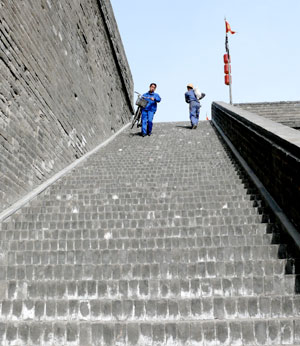XIAN, CHINA - Jiang Li (a.k.a. Ella) asked what other city walls I had walked on? “A few,” I responded but before getting a chance to name them, the local girl I met while walking Xi’an’s ancient stone fortress interrupted me and asked: “Okay, how many have you ridden a bicycle on?”
She had me stumped. Most city walls I had walked in Europe and North America were narrow – with just enough width for one or two people – no bikes. But Xi’an’s wall is massive. It stands 12 metres high and is 15 metres wide – certainly wide enough to handle the bicycles and peddle rickshaws we saw being offered for hire near its South Gate.
“How about joining me for a bicycle tour of the wall,” challenged Ella, a student at one of the city’s 70 universities. Without hesitation, I said: “sign me up.”
“Should we get single bikes or a bicycle built for two?” Ella asked.
“Please, we barely know each other – let’s stick to single bikes,” I jokingly told the pretty girl with infectious smile.
Ella joined me on a one and a half hour ride – the cost for each bike was 40 yuan (less than $10 Cdn.). The attendant wiped some grime off the fender and then assisted me as I mounted the bike which looked like it had been around since the wall’s corner stone was laid in 1374, during the Tang Dynasty.
“Stay close to me so you hear everything I have to say,” said the student who says she likes talking to “Americans” so she can improve her English.
Xi’an’s impressive city wall is the only one in China still intact. Other great cities like Beijing and Nanjing – like Xi’an, both served as China’s capital – also had walls but they disintegrated long ago and there are only remnants of those left.
As we peddled along the uncomfortable surface, Ella told me the wall looks most impressive at night when the four gate towers and 98 ramparts are lit up with thousands of coloured lights – a scene I later witnessed and one which left me speechless.
The city wall has four main gates at the south, north, east and west entrances and has a moat that completely encircles it. The south gate, also known as Yongan Gate, is the most impressive of the four. It’s the only one with a draw bridge that still works and where major city functions and celebrations are held. Three smaller gates have been punched through the south gate wall so local traffic can move freely.

Above: Ancient stairs lead to an ancient wall.
“When the city wall was built Xi’an was actually called Chang’an,” shouted Ella whose voice was being drowned out by the heavy traffic below.
As we peddled, we were afforded some spectacular views of the ancient city, which served as home to more than 70 Chinese emperors, including famous ones from the Han, Tang, Song and Qin Dynasties, over an 1,100-year period.
The perimeter of the wall is 11.9 kilometres and the fortification protects one of China’s most beautiful cities, a place where the famous Silk Road, which connected Asia to Europe, originated.
“You see down there,” said Ella as we passed an area of the city where a giant pagoda-style building sat guard in front of a narrow street.
“That area is the Muslim Quarter and it’s where 300,000 Chinese Muslims live – all descendents of people who came here during the time of the Silk Road.”
“And what’s that building in front of the street?” I called back.
“That’s the city’s Drum Tower – it was built in 1380, four years before the Bell Tower, which we’ll be coming upon in just a few minutes,” said Ella, who went on to explain the Bell Tower told people when it was time to go to work in the mornings and the Drum Tower told them when it was quitting time.
From the wall we saw Xi’an’s handsome European-style streets, lined with plane trees, the same kind you find in Paris and other French cities. The lovely twisted trees and their thick foliage form a natural canopy which protects the citizens of this city from its oppressive summer heat.
“Without those trees we would melt in summer,” laughed Ella as we came upon the east gate and then the north and then finally the west before starting our final push for home – back to the south gate.
“At one time over one million people lived within the city walls (during the Tang Dynasty) but now only about 500,000 people live within in the wall,” said Ella as we approached the rental station – just a few minutes before our time was up.
Ella asked if she had been helpful and wondered if her commentary had enlightened me about Xi’an and its city wall.
“The one thing I learned today,” I told her, “is that China has two Great Walls.”
About the Author
Marc Atchison is a veteran journalist and a seasoned traveller with more than 20 years of travel writing experience. As the former Travel Editor of the Toronto Star, Canada's largest newspaper, and now Editor-in-Chief and Senior Writer for TraveLife magazine (Canada) and travelife.ca, Marc has been to over 100 countries in the world. Japan is one of his favorite destinations and he's been there on numerous occasions.